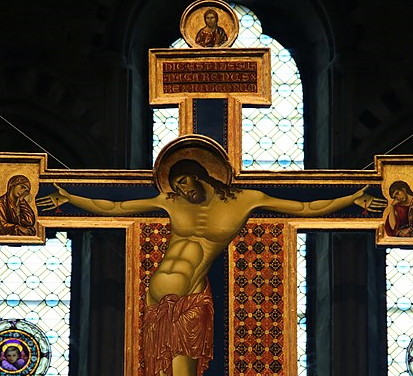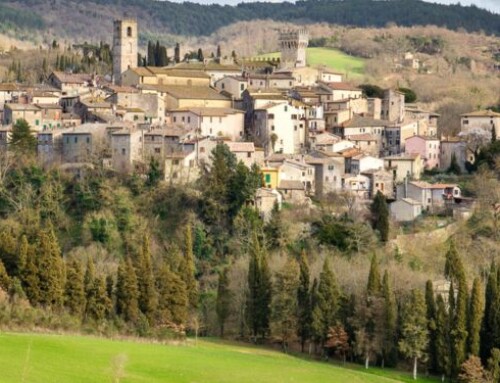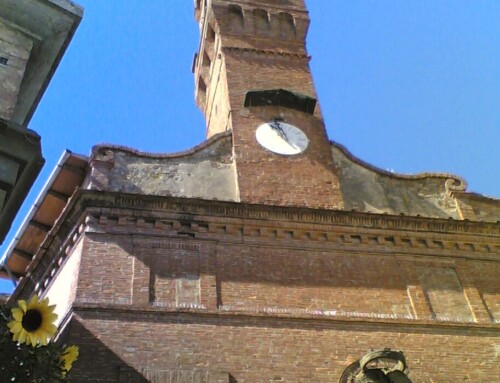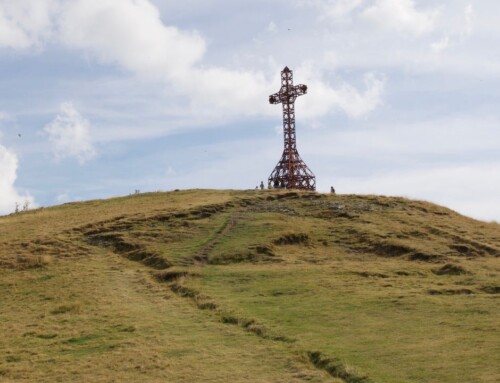Cimabue’s Crucifix to be admired in Arezzo

The Basilica of San Domenico in Arezzo, founded in 1275 and completed in the 14th century, is a fascinating example of Gothic architecture. With a simple brick facade and a spacious interior illuminated by stained glass windows, the basilica is not only a place of worship but also a custodian of important works of art, including Cimabue's famous Crucifix. Cimabue, born in Florence around 1240, is considered a pioneer of Italian painting, known for his innovative style combining realism and expression. His Crucifix, made between 1268 and 1271, depicts Christ in a dynamic and suffering pose. The work underwent significant restorations in 1917 and 2005. Today, the basilica is open to visitors year-round, offering a unique artistic and spiritual experience.
The Architecture and History of the Basilica of San Domenico
The Basilica of San Domenico in Arezzo is a fascinating testimony to Gothic architecture in Italy. Founded in 1275, the church was completed in the 14th century and reflects the sobriety and elegance typical of Dominican buildings. The structure features a simple brick façade and a spacious interior with aisles lit by stained glass windows. In addition to being a place of worship, the basilica is also a custodian of important works of art, including Cimabue’s famous Crucifix. Its history is intertwined with that of the city of Arezzo, representing a landmark for the local community and visitors.
Cimabue: A Pioneer of Italian Painting
Cimabue, born in Florence around 1240, is one of the most important artists of the 13th century, considered a precursor of the Renaissance. Known for his innovative style and ability to infuse emotion and realism into his works, Cimabue left an indelible mark on the history of art. Among his most significant works are the Crucifix of San Domenico in Arezzo and the Crucifix of Santa Croce in Florence. His painting technique, which combines Byzantine influences with a new sense of realism and drama, paved the way for generations of artists, including his famous pupil Giotto.
A True Masterpiece: Cimabue’s Crucifix of San Domenico
Cimabue’s Crucifix, preserved in the Basilica of San Domenico in Arezzo, is a shaped cross painted in tempera and gold on panel, with dimensions of 336×267 cm. Made between about 1268 and 1271, the work is known for its expressive and dynamic depiction of the crucified Christ. Cimabue innovated from Byzantine representations by arching Christ’s body more and using looser brushstrokes for the face, which appears gentle and suffering. The golden details in the drapery and robes of the mourners, Mary and St. John, add a precious luminosity to the scene, while the blessing Christ in the upper tondo is probably the work of a workshop assistant.
The Visual Language in Cimabue’s Crucifix in Arezzo
Cimabue, in his San Domenico Crucifix in Arezzo, develops a visual language that combines tradition and innovation. The artist adopts the iconography of the Christus patiens, drawing inspiration from models such as Giunta Pisano, but introduces significant stylistic variations. Christ’s body is rendered with an accentuated curvature and drapery that seems to glide naturally over the figure, emphasizing the suffering and humanity of the subject. The brushstrokes are fluid and soft, in stark contrast to the Byzantine stiffness, and the treatment of the face with a gentle, suffering expression creates an empathetic effect in the viewer. This innovative approach not only makes the work more accessible and moving, but also marks an important step toward Renaissance realism.
Conservation and Restoration of Cimabue’s Crucifix
The conservation of Cimabue’s Crucifix has been a priority for the Basilica of San Domenico in Arezzo. Made between 1268 and 1271, the work was not immediately recognized for its value; only in 1907 was it correctly attributed to Cimabue by Adolfo Venturi. The Crucifix has undergone major restoration, the first of which was in 1917, which aimed to stabilize the structure and preserve the original colors. The second restoration, which took place in 2005, used advanced technologies to remove impurities accumulated over time and restore the finely painted details by Cimabue. These efforts have ensured that the work will continue to be a priceless treasure for future generations.
The Influence of Giunta Pisano on Cimabue’s Crucifix
Cimabue, in creating the San Domenico Crucifix in Arezzo, clearly drew inspiration from Giunta Pisano’s Crucifix preserved in the basilica of San Domenico in Bologna. This connection is not accidental, as the Dominicans in Arezzo had expressly requested that their crucifix follow the Bologna model. However, Cimabue took the art to a higher level by introducing greater realism and dynamism. The bending of Christ’s body, the expressive use of color, and the refinement of the golden drapery demonstrate a significant stylistic evolution. These elements not only reflect the influences of Giunta Pisano, but also Cimabue’s ability to innovate and improve on existing models, creating a unique and powerful work.
The Dramaticity and Realism of Cimabue’s Crucifix
Cimabue’s Crucifix in the Basilica of San Domenico is a masterpiece of drama and realism. Cimabue depicted Christ with an arched and contorted body, detailed muscles and hands flattened on the cross, creating a powerful image of suffering and sacrifice. The use of red in the drapery symbolizes passion, while the golden streaks add a divine quality. Christ’s sweet, suffering face, with soft brushstrokes, breaks with Byzantine rigidity, introducing a realism that makes the scene more vivid and empathetic. This mix of symbolic and realistic elements demonstrates Cimabue’s ability to innovate and create works that deeply touch the faithful.
Visit to the Basilica of San Domenico: A Journey into the Art of Cimabue
The Basilica of San Domenico in Arezzo is the ideal place to discover Cimabue’s Crucifix and immerse yourself in medieval art. The church is open to visitors year-round and offers flexible hours for easy access. Once inside, visitors can admire the Crucifix in all its glory, as well as explore other 14th-century artworks and frescoes. For those who want a more in-depth understanding, guided tours are available that provide details on the history of the basilica, Cimabue’s artistic techniques, and the importance of the Crucifix. A visit to the basilica is not only an artistic experience, but also an opportunity to reflect on the spirituality and devotion that these works represent.
Visit the Cimabue Crucifix during your stay at the B&B Country House Poggio del Drago!
Dear guests of B&B Country House Poggio del Drago, during your stay we invite you to visit the Basilica of San Domenico to admire Cimabue’s Crucifix. This masterpiece of medieval art offers a unique combination of beauty and historical significance. Do not leave Arezzo without having had this unforgettable artistic and spiritual experience. Enjoy your exploration!
Reading Time: 5min
Table of Contents:
- The Architecture and History of the Basilica of San Domenico
- Cimabue: A Pioneer of Italian Painting
- A True Masterpiece: Cimabue’s Crucifix of San Domenico
- The Visual Language in Cimabue’s Crucifix in Arezzo
- Conservation and Restoration of Cimabue’s Crucifix
- The Influence of Giunta Pisano on Cimabue’s Crucifix
- The Dramaticity and Realism of Cimabue’s Crucifix
- Visit to the Basilica of San Domenico: A Journey into the Art of Cimabue
- Visit the Cimabue Crucifix during your stay at the B&B Country House Poggio del Drago!




